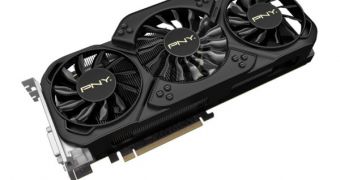Lots of custom-designed AMD Radeon R9 series graphics cards are appearing this month, and NVIDIA's own OEMs aren't about to stay silent while this is happening. PNY is one example.
The company has formally launched the factory-overclocked GeForce GTX 780 Ti XLR8 series (a play on the word “accelerate”).
As you can see in the photo, it has three fans coping with the heat load of this thing, and said heat load is higher than on the stock card.
After all, the GK110 graphics processing unit (GPU with 2,880 CUDA cores and 384-bit memory interface) works at 980 MHz (base frequency) or 1046 MHz on a tough day (GPU Boost maximum).
For the sake of comparison, the reference NVIDIA adapter has 876 MHz and 928 MHz clocks, respectively.
The rest of the specs are left alone though, not that there would have been much point for changes there.
After all, the clock of 7 GHz for the 3 GB of GDDR6 VRAM is already really high, and the rest of the components (capacitors, conductors, etc.) come with the PCB.
For those who still want the details, the PNY GTX 780 Ti XLR8 has two power inputs (one 6-pin and one 8-pin), two DVI outputs, one HDMI 1.4b port and DisplayPort 1.2 (again, one port).
Finally, the price of the product is of $749.99 / €749.99, regardless of what exchange rates will have you believe (€548).
For those that need a reminder, NVIDIA's GeForce GTX 780 Ti is the fastest single-GPU board out there right now, both among NVIDIA's own and in the video card market at large.
It supports PhysX technology, 3D Vision, SLI (multi-card configurations), CUDA technology (parallel processing of math tasks), OpenGL 4.4 and OpenCL. If it didn't have a price so much higher than AMD's Radeon R9 290X (arguably not altogether justified by the performance difference), it would rule the high-end video card industry unchallenged.

 14 DAY TRIAL //
14 DAY TRIAL //